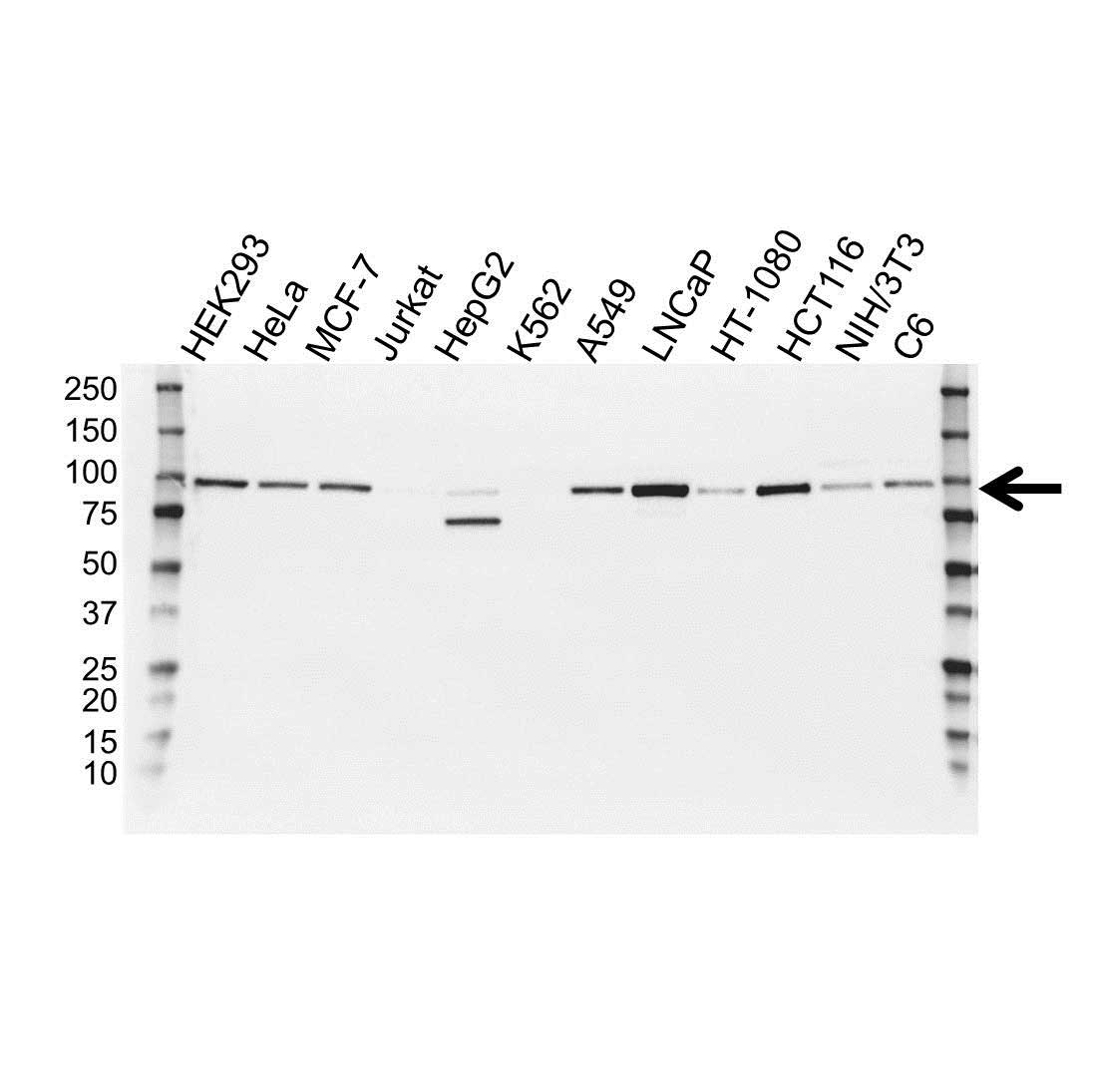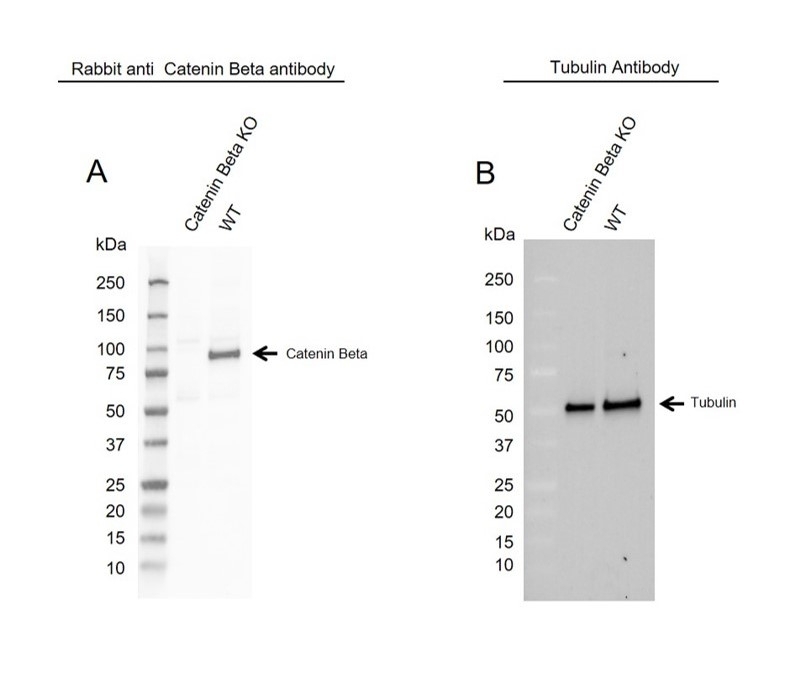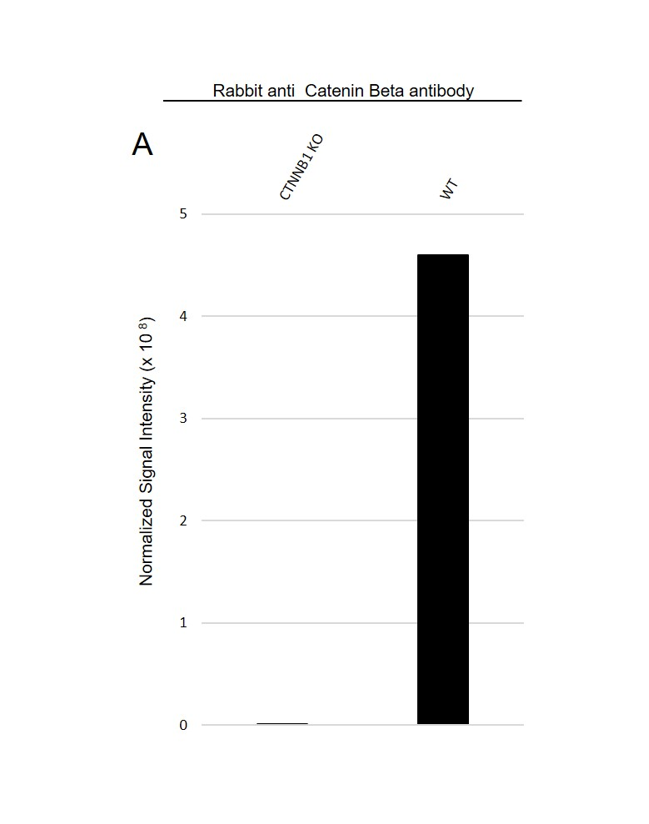Catenin Beta antibody



Rabbit anti Catenin Beta
- Product Type
- PrecisionAb Polyclonal
- Isotype
- Polyclonal IgG
- Format
- Purified
- Specificity
- Catenin Beta
- Target Species
- Human
- Western Blotting
- Anti catenin beta detects a band of approximately 90 kDa in HEK293 cell lysates.
- Species Cross-Reactivity
-
Target Species Cross Reactivity Mouse Rat - N.B. Antibody reactivity and working conditions may vary between species.
- Product Form
- Purified IgG - liquid
- Preparation
- Rabbit polyclonal antibody purified by affinity chromatography.
- Buffer Solution
- Phosphate buffered saline.
- Preservative Stabilisers
- 0.09% Sodium Azide (NaN3)
- Immunogen
- Synthetic peptide corresponding to the C terminus of catenin beta
- Approx. Protein Concentrations
- IgG concentration 1.15 mg/ml
- Regulatory
- For research purposes only.
- Guarantee
- 12 months from date of despatch.
- Acknowledgements
- PrecisionAb is a trademark of Bio-Rad Laboratories.
| Application Name | Verified | Min Dilution | Max Dilution |
|---|---|---|---|
| Western Blotting | 1/1000 |
| Description | Product Code | Applications | Pack Size | List Price | Your Price | Quantity | |
|---|---|---|---|---|---|---|---|
| Goat anti Rabbit IgG (H/L):HRP | STAR208P | WB | 2 ml |
|
Log in | ||
| List Price | Your Price | ||||||
|
|
Log in | ||||||
| Description | Goat anti Rabbit IgG (H/L):HRP | ||||||
- UniProt
- P35222
- Entrez Gene
- CTNNB1
- GO Terms
- GO:0000122 negative regulation of transcription from RNA polymerase II promoter
- GO:0005515 protein binding
- GO:0000578 embryonic axis specification
- GO:0001569 patterning of blood vessels
- GO:0001658 branching involved in ureteric bud morphogenesis
- GO:0001702 gastrulation with mouth forming second
- GO:0001711 endodermal cell fate commitment
- GO:0001837 epithelial to mesenchymal transition
- GO:0001889 liver development
- View More GO Terms
- GO:0003136 negative regulation of heart induction by canonical Wnt receptor signaling pathway
- GO:0003337 mesenchymal to epithelial transition involved in metanephros morphogenesis
- GO:0003704 specific RNA polymerase II transcription factor activity
- GO:0003713 transcription coactivator activity
- GO:0004871 signal transducer activity
- GO:0005198 structural molecule activity
- GO:0005667 transcription factor complex
- GO:0005813 centrosome
- GO:0005915 zonula adherens
- GO:0005916 fascia adherens
- GO:0005924 cell-substrate adherens junction
- GO:0005938 cell cortex
- GO:0006921 cellular component disassembly involved in apoptosis
- GO:0007016 cytoskeletal anchoring at plasma membrane
- GO:0007160 cell-matrix adhesion
- GO:0007268 synaptic transmission
- GO:0007398 ectoderm development
- GO:0007403 glial cell fate determination
- GO:0008022 protein C-terminus binding
- GO:0008285 negative regulation of cell proliferation
- GO:0042493 response to drug
- GO:0009898 internal side of plasma membrane
- GO:0009950 dorsal/ventral axis specification
- GO:0009954 proximal/distal pattern formation
- GO:0010552 positive regulation of gene-specific transcription from RNA polymerase II promoter
- GO:0010843 promoter binding
- GO:0010909 positive regulation of heparan sulfate proteoglycan biosynthetic process
- GO:0014010 Schwann cell proliferation
- GO:0016328 lateral plasma membrane
- GO:0016337 cell-cell adhesion
- GO:0016342 catenin complex
- GO:0016564 transcription repressor activity
- GO:0019901 protein kinase binding
- GO:0019903 protein phosphatase binding
- GO:0022009 central nervous system vasculogenesis
- GO:0030018 Z disc
- GO:0030027 lamellipodium
- GO:0030057 desmosome
- GO:0030331 estrogen receptor binding
- GO:0030521 androgen receptor signaling pathway
- GO:0030539 male genitalia development
- GO:0030902 hindbrain development
- GO:0030997 regulation of centriole-centriole cohesion
- GO:0031016 pancreas development
- GO:0031069 hair follicle morphogenesis
- GO:0031528 microvillus membrane
- GO:0032331 negative regulation of chondrocyte differentiation
- GO:0032355 response to estradiol stimulus
- GO:0032993 protein-DNA complex
- GO:0033077 T cell differentiation in thymus
- GO:0034333 adherens junction assembly
- GO:0034394 protein localization at cell surface
- GO:0034742 APC-Axin-1-beta-catenin complex
- GO:0034747 Axin-APC-beta-catenin-GSK3B complex
- GO:0042129 regulation of T cell proliferation
- GO:0042153 RPTP-like protein binding
- GO:0042475 odontogenesis of dentine-containing tooth
- GO:0043065 positive regulation of apoptosis
- GO:0043123 positive regulation of I-kappaB kinase/NF-kappaB cascade
- GO:0043198 dendritic shaft
- GO:0043410 positive regulation of MAPKKK cascade
- GO:0043587 tongue morphogenesis
- GO:0044325 ion channel binding
- GO:0044334 canonical Wnt receptor signaling pathway involved in positive regulation of epithelial to mesenchymal transition
- GO:0044336 canonical Wnt receptor signaling pathway involved in negative regulation of apoptosis
- GO:0045202 synapse
- GO:0045294 alpha-catenin binding
- GO:0045296 cadherin binding
- GO:0045669 positive regulation of osteoblast differentiation
- GO:0045671 negative regulation of osteoclast differentiation
- GO:0045743 positive regulation of fibroblast growth factor receptor signaling pathway
- GO:0045765 regulation of angiogenesis
- GO:0045768 positive regulation of anti-apoptosis
- GO:0048145 regulation of fibroblast proliferation
- GO:0048262 determination of dorsal/ventral asymmetry
- GO:0048471 perinuclear region of cytoplasm
- GO:0048489 synaptic vesicle transport
- GO:0048538 thymus development
- GO:0048599 oocyte development
- GO:0048617 embryonic foregut morphogenesis
- GO:0048660 regulation of smooth muscle cell proliferation
- GO:0050681 androgen receptor binding
- GO:0050808 synapse organization
- GO:0051145 smooth muscle cell differentiation
- GO:0051149 positive regulation of muscle cell differentiation
- GO:0060440 trachea formation
- GO:0060479 lung cell differentiation
- GO:0060484 lung-associated mesenchyme development
- GO:0060492 lung induction
- GO:0060769 positive regulation of epithelial cell proliferation involved in prostate gland development
- GO:0060789 hair follicle placode formation
- GO:0060916 mesenchymal cell proliferation involved in lung development
- GO:0061047 positive regulation of branching involved in lung morphogenesis
- GO:0061154 endothelial tube morphogenesis
- GO:0070369 beta-catenin-TCF7L2 complex
- GO:0070411 I-SMAD binding
- GO:0070412 R-SMAD binding
- GO:0070602 regulation of centromeric sister chromatid cohesion
- GO:0071363 cellular response to growth factor stimulus
- GO:0071681 cellular response to indole-3-methanol
- GO:0072033 renal vesicle formation
- GO:0072053 renal inner medulla development
- GO:0072054 renal outer medulla development
- GO:0072079 nephron tubule formation
- GO:0090279 regulation of calcium ion import
- GO:2000008 regulation of protein localization at cell surface
VPA00164
If you cannot find the batch/lot you are looking for please contact our technical support team for assistance.
Please Note: All Products are "FOR RESEARCH PURPOSES ONLY"
View all Anti-Human ProductsAlways be the first to know.
When we launch new products and resources to help you achieve more in the lab.
Yes, sign me up


